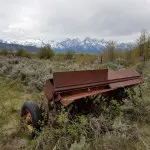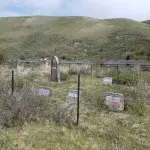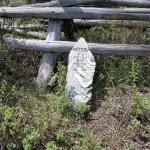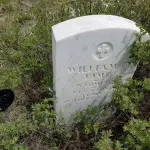The Kelly Cemetery is located northeast of the town of Kelly. Located on a forgotten 40-acre tract of land that ended up in between two other 160-acre homesteads, the neighbors agreed it should be set aside for use as a cemetery. It was used sporadically from until May of 1927 when a massive flood flattened the town. Six people died as a result, and three of them were buried in the cemetery far away from where the floodwaters had risen. There are several references to an older Kelly cemetery south of town, however little evidence remains. It is believed to be on private land, and only slight depressions are visible, and all markers have since been lost to time. Access to the current Kelly Cemetery is through private lands, and permission is required through Grand Teton National Park. The land was originally part of the Albert and Sarah Nelson homestead, and both are buried in the Allen Cemetery at Moran.
Kneedy Family
Milton Kneedy arrived in the valley from Kansas, where he operated a flourmill. He endeavored to open a flourmill in Kelly, and was successful until a fire destroyed the mill and the storehouses in 1921. On May 18, 1927, Milton, his wife Margaret and their adopted son Joe were swept away by floodwaters, believing the reports of rising water to be untrue. They were buried together, with a single marker in the Kelly Cemetery. Three others drowned in the same flood, but were buried elsewhere in the valley. The only surviving Kneedy member was Ida, who was living on Mormon Row with her husband Andy Chambers when the flood hit. To read more about the flood, visit our Kelly Flood page.
Luther Taylor
Today, the Luther Taylor homestead is one of the most popular tourist destinations in Jackson Hole. It is known as the “Shane Cabin” due to its appearance in the 1953 western movie Shane. Few who visit are aware of its significance as one of the oldest intact original homesteads in the valley. When Luther Taylor purchased the homestead in 1923, he inherited two modest barn-style buildings constructed by John Erwin, the original homesteader. Taylor’s skill in cabin building is still evident, despite more than 65 years of deferred maintenance. Large stone piers support wide floorboards, with distinctive mud and woodchip chinking between the large horizontal logs. Most built their first homes with meager materials, intending to replace them at a later date. Taylor carefully crafted his house with permanence in mind, and a window perfectly framing the Teton Range in the west. For more information on the homestead, visit our Luther Taylor page.
William G. Jump
William’s father, Bill Jump, worked as a wrangler at the Bar BC Dude Ranch on the western side of the valley. In 1925, he received the patent for his homestead on Lost Creek. In 1926, Bill Jump was ill in the hospital when he was paid a visit by his friend John S. Turner, who was looking to purchase the Jump homestead. Jump agreed to the deal, having sold for twice the value of the land. When Bill left the hospital, he went to live with his son William. Turner constructed a large log cabin that he and his sons lived in that winter. The Turners quickly converted their new land into a modest dude ranch, that hosted 20 dudes by 1927. For more on the dude ranch, visit our Triangle X page.
This cemetery has restricted access, please be respectful of and observe all postage signage when visiting.




